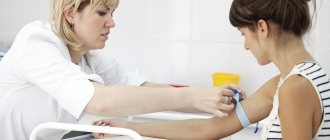Home — Rules for preparing a patient for laboratory and ultrasound examinations — Preparation for blood tests
Food restrictions | Capillary blood | General clinical analysis | Biochemistry | Coagulogram | Hormones | Infections | Glucose tolerance test | TSH | Vitamin D
Blood counts can change significantly throughout the day, so it is recommended to take tests in the morning. For this period, reference intervals for many laboratory parameters have been calculated. This is especially important for hormonal studies.
- All blood tests are done before radiography, ultrasound and physiotherapeutic procedures.
- Do not smoke 2 hours before donating blood.
- For 2-3 days, do not overeat, especially fatty foods, avoid alcohol, intense physical activity, and also do not visit the bathhouse or sauna.
Food restrictions:
- On an empty stomach: at least 4 hours after the last (not large!) meal.
- Strictly on an empty stomach: at least 8 hours after the last meal. In newborns and children in the first months of life, blood sampling is allowed no earlier than 2 hours after eating.
- Fasting: no food intake for at least 12-14 hours.
- Drinking regime . Drinking water does not affect blood counts, so drinking water is allowed (not mineral, non-carbonated). Juice, tea, coffee are prohibited.
How to read results
In commercial laboratories, the result is given on a form where standards are indicated along with the indicators. This is convenient for perception, since shifts in one direction or another are immediately visible. Moreover, the standards are indicated separately for men, women and children. And this is important to consider, especially in childhood.
pixabay.com/
As you grow older, the composition of your blood changes. And the standards that are relevant for a month-old baby are no longer suitable for a one-year-old baby. Therefore, age limits have been introduced for children:
- up to a year;
- from one to six years;
- from seven to 12 years;
- from 13 to 15 years.
And only then the indicators approach those of adults, for men and women. But even the deciphered results do not use such a clear gradation. Therefore, only a doctor should read the analysis and interpret it. After all, when studying on your own, there is a high risk of making a mistake and diagnosing diseases that you or your child do not have.
In addition, a general analysis is a primary diagnosis. And it is usually not enough to make a diagnosis. Your doctor may order other types of tests. And based on the data obtained, establish the cause of the disease and recommend treatment. So studying the “blood picture” by the patient is, as a rule, pointless. These numbers on paper only have meaning in context. And only a doctor can examine it.
Hormones
Blood collection is carried out strictly on an empty stomach: at least 8 hours must pass from the last meal (preferably at least 12 hours). You are allowed to drink water (non-mineral, non-carbonated). It is forbidden to drink juice, tea, coffee. 2-3 days before the test, do not overeat, especially fatty foods. Avoid alcohol, intense physical activity, and do not visit the sauna or bathhouse.
- On the day of blood collection, avoid taking medications; if withdrawal is not possible, inform the laboratory.
- When studying hormones over time, it is advisable to take blood samples at the same time of day.
- Some hormones need to be taken by women on certain days of the menstrual cycle. This information can be obtained from your doctor.
Attention!Q Blood collection for cortisol is carried out strictly on an empty stomach, strictly in the interval from 8:00 to 11:00 (the exact time of venipuncture is indicated).
Technique for collecting capillary blood from a finger
- Soak a cotton ball (gauze) in an antiseptic.
- With one hand, take the 4th finger of the patient's free hand, massage it lightly, pinching the upper phalanx of the finger with the index and thumb.
- With the other hand, treat the inner surface of the upper phalanx of the patient’s finger with an antiseptic with a cotton ball (gauze) soaked in an antiseptic. Dry the surface of the finger with a dry sterile cloth (cotton ball).
- Place the used napkin (ball) in the consumables tray.
- After the skin has dried, take a scarifier and puncture the skin with a quick movement.
- Place the used scarifier in a puncture-resistant waste container.
- Wipe off the first drops of blood with a dry sterile cloth (cotton ball). Place the used napkin (ball) in the consumables tray.
- By gravity or using a capillary, collect the required amount of blood. The volume of blood drawn must correspond to the mark on the tube.
- Press a napkin (cotton ball) with an antiseptic solution to the puncture site. Ask the patient to hold a napkin (cotton ball) at the puncture site for 2-3 minutes.
- Invert the tube into a vertical position to transfer blood from the capillary to the tube.
- Turn the cap off the tube, remove it, and place it in a puncture-proof container along with the built-in capillary without disassembling it.
- Remove the cap from the base of the test tube, tightly close the test tube or close the test tube with a cap until it clicks (depending on the modification of the test tube).
- Mix the sample thoroughly by inverting the test tube.
Glucose tolerance test
Attention: A glucose tolerance test is prescribed only after consulting a doctor. This study is not performed for patients with type 1 diabetes mellitus.
Blood collection is carried out in the morning, after fasting: at least 12-14 hours must pass from the last meal.
- Before performing the glucose tolerance test, follow a diet for 3 days (no more than 150 grams of carbohydrates per day), exclude intense physical activity, and do not visit the bathhouse or sauna.
- 3 days before the test, stop thiazide diuretics, contraceptives and glucocorticoids (in consultation with your doctor).
- Do not drink water or smoke during the study. Repeated blood sampling is carried out 1 hour and 2 hours after the “load” of glucose.
What is a biochemical analysis and why is it prescribed?
The content of the article
Biochemical blood testing is the most important diagnostic measure, which makes it possible to obtain an accurate assessment of lipid, protein and carbohydrate metabolism. These indicators are important for a huge number of pathologies and diseases, and therefore blood biochemistry is considered one of the basic tests of laboratory diagnostics.
The content of biochemical substances is assessed by their concentration, which is compared with normal values. If the concentration of a particular factor deviates from the norm, conclusions are drawn about the likelihood of a particular disease.
Preparing for a thyroid-stimulating hormone (TSH) test
TSH levels are the most sensitive test for assessing thyroid function. However, it remains the most frequently deviating from the reference interval among all hormonal studies. To obtain reliable results, in addition to the general rules for preparing for laboratory tests, it is important to follow the rules below:
- The TSH level changes significantly during the day: its highest concentration is determined in the morning, and its minimum in the evening. You should donate blood at the same time, especially in case of repeated tests, since the time of blood donation plays an important role in the interpretation of the TSH level.
- In the case of thyroid hormone replacement therapy, it is necessary to take the drug after drawing blood for testing. Taking thyroxine and iodine the day before the test does not affect the TSH concentration. It is advisable to carry out repeated studies of TSH levels in order to monitor therapy no earlier than 6 weeks after changing the dose or type of drug.
- It must be remembered that the TSH result may be distorted by the effects of medications taken or the products of their metabolism. Before donating blood for analysis, you should consult your doctor about the possibility of limiting the intake of medications during the period of preparation for the study. It is recommended that you stop taking medications, including dietary supplements, before the study. If it is impossible to stop taking medications, you should provide the name of the drug and the time of its last use when donating blood.
- The thyroid gland is associated with the work of many organ systems, disorders in which can affect the secretion of the hormone: acute and chronic stress, acute infectious diseases, disorders of lipid and vitamin metabolism, leading to excess cholesterol, homocysteine, as well as disturbances in sleep patterns and wakefulness at night, which disrupt the normal rhythm of TSH secretion. The influence of these conditions must be taken into account when interpreting the results if it is not possible to postpone the study to a later date.
- Different research methods may be used in different laboratories, therefore, in order to correctly evaluate the research results, it is necessary to conduct research in the same laboratory and on the same analytical system.
General blood test indicators
The widespread dissemination of the procedure made it necessary to standardize its data. The standard analysis contains information about:
- hemoglobin (g/l);
- erythrocytes (x106/µl);
- blood color index;
- reticulocytes (%);
- platelets (x103/µl);
- thrombocrit;
- leukocytes (x103/µl);
- leukocyte formula (neutrophils, eosinophils, basophilic granulocytes, lymphocytes, monocytes);
- plasma cells (U).
Hemoglobin (Hb) levels are extremely important for breathing. This substance is able to temporarily combine with oxygen molecules and transport it, delivering it to every cell of the body. Having released oxygen, the protein binds with hydrogen ions and carbon dioxide, carrying the latter back to the lungs. Hemoglobin levels depend on gender and age, but especially fluctuate in childhood (from 145-225 g/l in the first days after birth to 95-135 g/l at 3-6 months, followed by an increase to normal levels in adults). The indigenous people of the highlands have a naturally higher level of hemoglobin in the bloodstream compared to other people.
Red blood cells (RBCs) are the most abundant in blood. It is these bodies that contain hemoglobin, performing the same functions as iron-containing protein. The main role of red blood cells is to transport hemoglobin through the bloodstream and protect the body from the toxic effect of free protein.
The role of the color index (MCHC) is to determine the degree of saturation of red blood cells with hemoglobin.
The percentage of reticulocytes—immature red blood cells—in the bloodstream varies between children and adults. In newborns, their number can reach up to 10%, gradually decreasing and stopping at an older age by 0.5-2%. These cells are also capable of carrying oxygen, but their main task is to compensate for the deficiency of red blood cells when the indicator drops.
The platelet count (PLT) measures the blood's ability to clot. The platelet content in the bloodstream is normally the same in men and women (150-400 thousand/µl), but is slightly different in newborns (180-490 thousand/µl) and older children (160-390 thousand/µl). Platelets ensure the rapid formation of a protective plug that closes the rupture of the vessel.
In addition to the quantitative indicator, the CBC results display the percentage of platelets in the bloodstream - thrombocrit (PST).
An important indicator of health is the erythrocyte sedimentation rate (ESR), which reflects the ratio of plasma proteins.
The task of white blood cells (WBC) is to protect against foreign pathogens (viruses, bacteria, allergens), as well as to eliminate cell debris from the body after they die. The number of white blood cells in children is higher than in adults. In babies under one year old, their number reaches 6.0-17.5 thousand/µl, but with age the level of leukocytes drops, normally amounting to 4.5-11.0 x103/µl in adults.
The body produces 5 main types of leukocytes, the percentage of which is indicated by the leukocyte formula. The majority of white blood cells are neutrophils - microphages responsible for the absorption of foreign particles. After phagocytosis, they die, releasing antibiotic proteins into the blood. Eosinophils are also capable of microphagocytosis, but provide antiparasitic protection through the release of cytotoxic components.
Monocytes are the main macrophages responsible for the fight against viruses, microbes, parasites, and tumors due to the secretion of cytotoxins, interleukins, interferon, and antitumor factors.
Lymphocytes are the main immune cells that provide detection, storage of antigens, and production of antibodies against them. They also regulate the intensity of the immune response.
Basophils are involved in the formation of an allergic reaction, and also contribute to enhancing the immune response at the site of inflammation.
A separate form of lymphocytes, normally not detected in a blood test, are plasma cells. They appear as a response to the penetration of a pathogen and the onset of an inflammatory reaction, from B lymphocytes and are involved in the production of immunoglobulins.
The short form of the general analysis does not provide the values of ESR and leukocyte formula. But to establish a diagnosis, knowledge of the physiological norms of blood components is not enough. It is important to correctly evaluate the obtained values and correlate them with existing symptoms, since a deviation from the normal number of different types of cells is just a nonspecific sign indicating the presence of a pathological process.
Causes of monocytosis
The causes of monocytosis with a pathological increase usually reflect the degree of participation of one’s own immunity in anti-inflammatory activity. Elevated monocytes in the blood are detected when:
- viral infections (flu, respiratory disease, mumps, mononucleosis);
- bacterial and fungal infections (tuberculosis, syphilis, candidiasis);
- helminthic infestation in children;
- rheumatic damage to the heart and joints;
- bacterial septic endocarditis;
- enteritis, colitis of bacterial and fungal etiology;
- cases of sepsis;
- conditions after surgical treatment of appendicitis, gynecological operations;
- systemic autoimmune diseases (rheumatoid polyarthritis, sarcoidosis, lupus erythematosus);
- tumors from the blood line (lymphogranulomatosis, myeloid leukemia, thrombocytopenic purpura);
- malignant tumors.
Why is an increase in monocytes dangerous?
An increase in monocytes in the body in most cases indicates the presence of pathology. When an infectious disease appears, the body begins a stubborn fight against it by additionally producing white cells to actively fight the disease. It seems that the more monocytes, the better, because this way you can quickly cope with the disease. In fact, there is a downside, since an excessive amount of them can itself provoke inflammation.
Large accumulations of white bodies in the vessels can:
- Disrupt blood flow.
- Strengthen atherosclerosis.
- Reduce blood flow to the heart muscle.
- Cause damage to the vessel wall.
How is the level of monocytes in the blood determined?
In order to determine the number of monocytes contained in the blood, it is enough to take a general blood test. Monocytes are a type of leukocyte, calculated by a laboratory assistant using a special leukocyte formula. There are two indicators of monocytes:
- Absolute quantity
– designated as “monocytes abs” or “monocytes mono”, the average number of cells per 1 μl (microliter) is taken into account.
- Relative quantity
– designated as “value” ppm/l, calculated as a percentage
Functions of monocytes
When aggressive substances or microorganisms enter the surface of the mucous membrane of the nasopharynx or intestine, histiocytes flock to the lesion. These are “ripe” monocytes, adapted to life in tissues. If necessary, new portions of histiocytes-macrophages are urgently prepared.
They surround bacteria, viruses, fungi, and foreign particles, draw them into the protoplasm and provide work to lysosomes to completely dissolve unnecessary molecules.
Having cleared the “battlefield” of toxins and decayed leukocytes, macrophages move on to the process of transmitting information to subsequent generations. This ensures quick recognition of “friends” and “strangers” and aims the body at defense.
Unlike eosinophils, neutrophils, and lymphocytes, cells of the monocyte series are able to “fight” large species of the “enemy” and do not die immediately after the “attack.” Can be reused.








